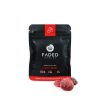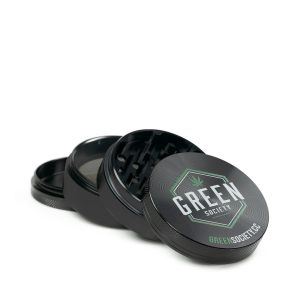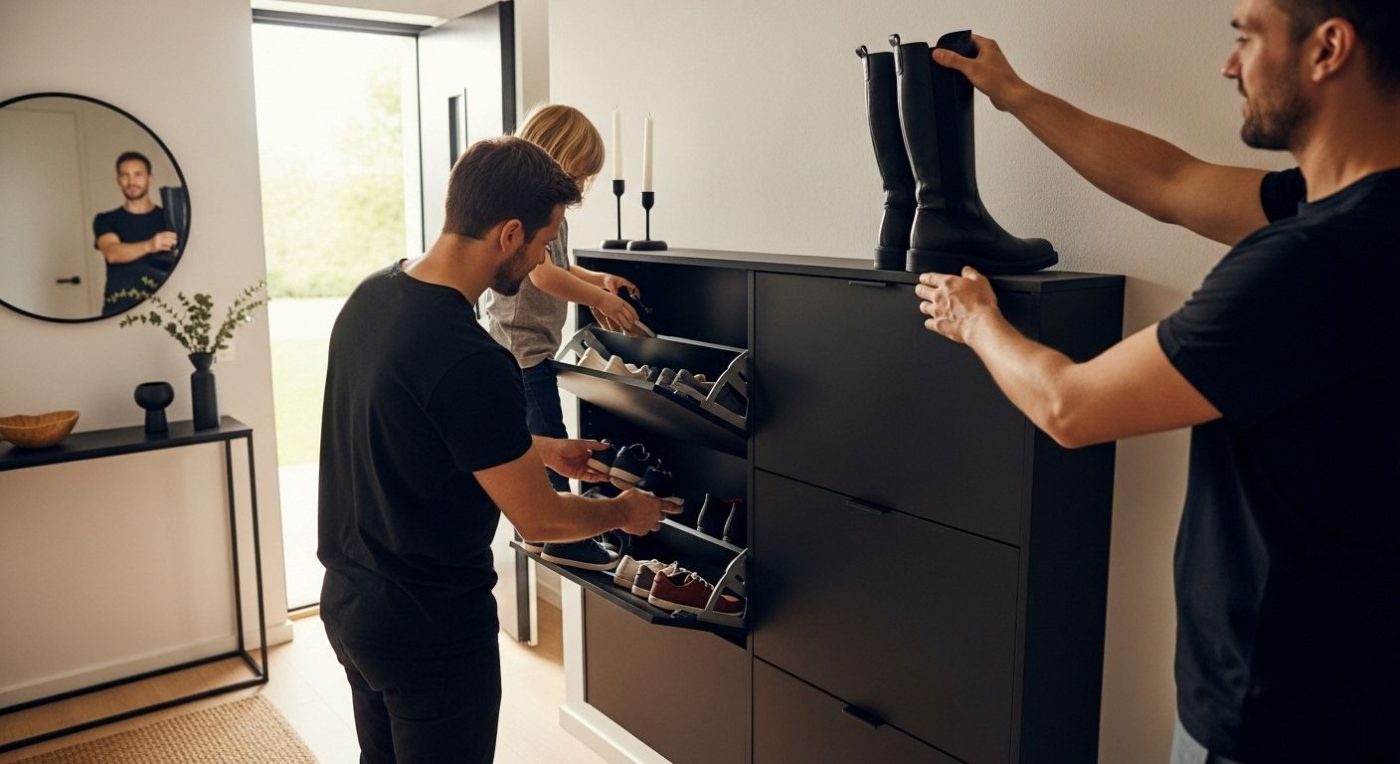Marijuana
7 Key Tips for Innovative Shoe Cabinet Design
A shoe cabinet might look like just another piece of furniture, but in reality it shapes how your entire space stays clean and organised. Most people focus on where to put their shoes, expecting only clutter control. Yet well-designed shoe cabinets can actually lower the risk of household tripping hazards and help prevent indoor moisture buildup according to the CDC. That means your next shoe cabinet could play a bigger role in home safety and health than you ever expected.
Table of Contents
- Understand The Purpose Of A Shoe Cabinet
- Choose The Right Size For Your Space
- Select Functional Materials For Durability
- Incorporate Smart Storage Solutions
- Design For Easy Cleanup And Maintenance
- Customize For Your Personal Style
- Utilize Vertical Space Effectively
Quick Summary
| Takeaway | Explanation |
|---|---|
| Consider shoe cabinet’s multi-functional purpose | A shoe cabinet organizes shoes, enhances home cleanliness, and prevents tripping hazards, contributing to household safety. |
| Select appropriate size based on space and needs | Measure your space accurately and consider family shoe needs to choose a cabinet that fits well without crowding. |
| Choose durable materials for longevity | Opt for moisture-resistant and easy-to-clean materials that maintain structural integrity and enhance cabinet lifespan. |
| Incorporate smart storage features | Use adjustable shelves and innovative storage solutions to maximize efficiency, visibility, and ease of access in your cabinet. |
| Design for easy cleaning and maintenance | Select smooth surfaces and removable components to facilitate quick cleaning and prevent moisture buildup, ensuring longevity. |
1: Understand the Purpose of a Shoe Cabinet
A shoe cabinet is more than just storage furniture it is a strategic solution for maintaining organisation, cleanliness, and functionality in your living space. When designing a shoe cabinet, understanding its core purposes will help you create a solution that goes beyond simple shoe containment.
The primary function of a shoe cabinet extends far beyond merely keeping shoes in one place. Effective shoe cabinet design addresses multiple practical needs in a household. According to the Centers for Disease Control and Prevention, creating organised storage areas can help reduce household clutter and minimise tripping hazards, which is crucial for home safety.
Key purposes of a well-designed shoe cabinet include:
- Protecting flooring and interior spaces from dirt, mud, and outdoor contaminants
- Maintaining shoe quality by providing appropriate storage conditions
- Creating visual organisation in entryways and living areas
- Reducing indoor moisture and potential mould growth by allowing proper shoe ventilation
When considering shoe cabinet design, homeowners should recognize that this piece of furniture serves multiple functions. It acts as a transition point between outdoor and indoor environments, helping to keep living spaces clean and organised. The design must balance aesthetic appeal with practical utility, ensuring shoes are stored efficiently while complementing the overall interior design.
Moreover, a thoughtfully designed shoe cabinet can contribute to home hygiene and health. By providing a designated space for shoes, you prevent tracking dirt, bacteria, and potential outdoor contaminants throughout your living areas. This is particularly important in households with children, pets, or individuals with respiratory sensitivities.
Ultimately, understanding the multifaceted purpose of a shoe cabinet transforms it from a simple storage solution to an essential element of home organisation and cleanliness. The right design considers not just shoe storage, but also aesthetic harmony, spatial efficiency, and overall household maintenance.
2: Choose the Right Size for Your Space
Selecting the appropriate size for your shoe cabinet is a critical decision that impacts both functionality and aesthetic appeal in your living space. The right dimensions depend on several crucial factors that go beyond simple measurements, requiring careful consideration of your specific household needs and spatial constraints.
According to ADA Accessibility Standards, proper spatial planning is essential when integrating furniture into living areas. This means considering not just the cabinet’s size, but how it interacts with available space and maintains smooth traffic flow.
Key considerations for determining shoe cabinet size include:
- Total number of shoes in your household
- Available floor and wall space
- Typical shoe sizes used by family members
- Location of intended cabinet placement
Measuring your space accurately is the first step toward selecting an appropriately sized shoe cabinet. Take precise measurements of the intended installation area, accounting for potential obstacles like doorways, electrical outlets, or adjacent furniture. Consider leaving at least 36 inches of clearance around the cabinet to ensure comfortable movement and accessibility.
For smaller living spaces, vertical designs offer maximum storage with minimal footprint. Tall, narrow cabinets can accommodate numerous shoe pairs while consuming minimal floor space. Conversely, larger homes might benefit from wider cabinets that provide more horizontal storage options.
Family composition significantly influences cabinet sizing. A household with multiple individuals will require larger storage capacity compared to a single person’s living space. Consider not just current shoe collections but potential future additions when planning your cabinet dimensions.
Additionally, think about shoe variety. Different footwear types sports shoes, dress shoes, boots require varying storage heights and configurations. A well-designed shoe cabinet adapts to these diverse requirements, providing adjustable shelving or compartments that accommodate different shoe styles and sizes.
Ultimately, choosing the right size involves balancing practical storage needs with aesthetic considerations, ensuring your shoe cabinet enhances rather than compromises your living space’s functionality and design.
3: Select Functional Materials for Durability
Choosing the right materials for your shoe cabinet is fundamental to creating a long lasting storage solution that withstands daily wear and environmental challenges. Material selection impacts not just appearance, but overall performance and longevity of your shoe storage system.
According to the USDA Forest Service Wood Handbook, understanding material properties is crucial for designing furniture that maintains structural integrity over time.
Key material considerations for shoe cabinet durability include:
- Resistance to moisture and humidity
- Structural strength and load-bearing capacity
- Ease of cleaning and maintenance
- Compatibility with home aesthetic
Engineered wood products offer excellent alternatives to traditional solid wood. Materials like medium-density fiberboard (MDF) and plywood provide superior stability, resisting warping and dimensional changes more effectively than solid wood. These engineered materials also tend to be more cost-effective and environmentally sustainable.
Metal components can significantly enhance durability. Aluminum and stainless steel hardware provide corrosion resistance and structural support. Look for powder-coated finishes that add an extra layer of protection against scratches and environmental wear.
Consider the environmental conditions of your installation space. Cabinets in high-humidity areas like entryways or near exterior doors require materials with superior moisture resistance. Tropical hardwoods, marine-grade plywood, or specially treated composites can offer enhanced performance in challenging environments.
The finish of your shoe cabinet materials matters as much as the base material. Protective coatings like polyurethane, lacquer, or specialized sealants can dramatically extend the lifespan of your furniture. These treatments guard against moisture, UV damage, and daily wear, maintaining both aesthetic appeal and structural integrity.
Ultimately, selecting functional materials is about balancing practical performance with aesthetic preferences. A well-chosen material not only supports your storage needs but becomes a lasting, attractive addition to your living space.
4: Incorporate Smart Storage Solutions
Transforming a basic shoe cabinet into a sophisticated storage system requires thoughtful design and innovative solutions. Smart storage goes beyond simple compartmentalization, focusing on maximizing functionality, accessibility, and organisation.
According to the ADA Standards for Accessible Design, storage solutions must prioritize usability and reach, principles that directly apply to shoe cabinet design.
Key smart storage strategies include:
- Adjustable shelving for different shoe sizes
- Integrated ventilation systems
- Pull-out drawer mechanisms
- Modular compartment configurations
Vertical organisation strategies can dramatically improve storage efficiency. Implement tiered shelving that accommodates various shoe types shoes, boots, sneakers creating clear visual separation and maximising vertical space. Angled shelves or slightly tilted compartments allow better shoe visibility and easier access.
Consider incorporating specialized storage features like:
- Dedicated boot holders
- Moisture-absorbing liners
- Removable trays for easy cleaning
- Hidden compartments for less frequently used footwear
Integrating technology can elevate your shoe cabinet’s functionality. Smart sensors can monitor humidity levels, while built-in deodorising systems help maintain fresh-smelling storage. Some advanced designs even include UV sanitisation features to keep shoes clean and bacteria-free.
Ergonomic design principles are crucial. Position frequently used shoe compartments at easily accessible heights, reducing unnecessary bending or stretching. Soft-close mechanisms and smooth-glide drawer systems enhance user experience and prevent potential damage.
Ventilation is another critical aspect of smart storage. Perforated backing or side panels allow air circulation, preventing moisture buildup and potential odour development. This design consideration extends shoe longevity and maintains a healthier storage environment.
Ultimately, smart storage solutions transform a shoe cabinet from a simple storage unit into an intelligent, adaptive system that anticipates and meets your specific organisational needs.
5: Design for Easy Cleanup and Maintenance
Designing a shoe cabinet with easy cleanup and maintenance in mind transforms a storage solution from merely functional to truly practical. Strategic design choices can dramatically reduce cleaning time and preserve the cabinet’s appearance over years of regular use.
According to the EPA’s Residential Mold Guide, preventing moisture buildup is crucial for maintaining a healthy home environment, which directly applies to shoe storage design.
Key maintenance considerations include:
- Selecting smooth, non-porous surface materials
- Minimising hidden corners and complex joints
- Choosing finishes resistant to moisture and stains
- Incorporating removable components for thorough cleaning
Surface selection plays a critical role in maintenance efficiency. Opt for materials like sealed laminate, tempered glass, or powder-coated metal that can be easily wiped down with a damp cloth. Avoid textured surfaces or intricate designs that trap dust and dirt, making thorough cleaning challenging.
Ventilation is another essential maintenance factor. Design cabinets with adequate airflow to prevent moisture accumulation, which can lead to mould growth and unpleasant odours. Perforated back panels, slatted doors, or small ventilation gaps can significantly improve air circulation and keep shoes fresh.
Removable components dramatically simplify cleaning processes. Consider:
- Washable fabric shoe bags
- Removable plastic or silicone liners
- Sliding trays that can be easily extracted
- Modular shelves that disassemble quickly
Finish selection directly impacts long-term maintenance. Water-resistant and stain-repellent coatings protect the cabinet from moisture damage and make surface cleaning more straightforward. Look for materials with inherent antimicrobial properties or those that can be easily treated with protective sealants.
Additionally, design the cabinet with practical cleaning access in mind. Ensure interior spaces can be reached with standard cleaning tools like microfiber cloths, small vacuum attachments, or disinfectant wipes. Avoid deep, narrow compartments that prevent thorough cleaning.
Ultimately, an intelligently designed shoe cabinet becomes a low-maintenance solution that keeps your space organised, clean, and visually appealing with minimal effort.
6: Customize for Your Personal Style
Customizing your shoe cabinet transforms it from a mere storage solution into a personal design statement that reflects your unique aesthetic and lifestyle. Style customization goes beyond visual appeal, integrating functionality with individual expression and home decor sensibilities.
According to a UCLA study on home environments, personalized spaces can significantly impact mood and emotional well-being, making your shoe cabinet more than just furniture.
Style customization strategies include:
- Matching existing furniture finishes
- Selecting complementary color schemes
- Incorporating decorative hardware
- Adding personal artistic elements
Color selection plays a critical role in seamlessly integrating your shoe cabinet into existing decor. Consider your home’s current palette selecting finishes that either blend harmoniously or provide a deliberate accent. Neutral tones like white, grey, and wood grains offer versatile options that adapt to changing interior design trends.
Hardware provides an opportunity for personal expression. Unique drawer pulls, handles, and knobs can transform a standard cabinet into a distinctive piece. Materials like brushed brass, matte black, or vintage ceramic can add character and reflect personal taste.
Texture and finish options expand customization possibilities:
- Distressed wood for rustic charm
- High-gloss surfaces for modern elegance
- Textured laminates mimicking natural materials
- Painted finishes with custom color matching
Consider integrating decorative elements that tell a story. Incorporate family photos, travel mementos, or artistic panels into cabinet doors. Some designs allow for interchangeable front panels, enabling periodic style refreshes without replacing the entire unit.
Practical personalization also matters. Adjust internal configurations to match your specific shoe collection. Sports enthusiasts might want specialized boot storage, while formal shoe collectors could design compartments with precise dimensions and protective features.
Ultimately, a customized shoe cabinet becomes more than storage it becomes a personal design statement that enhances your living space while providing practical functionality.
7: Utilize Vertical Space Effectively
Vertical space represents an often overlooked opportunity in shoe cabinet design, offering remarkable potential for maximizing storage efficiency and organisational potential. Strategic vertical utilisation transforms limited floor space into a comprehensive storage solution that adapts to diverse household needs.
According to the ADA Standards for Accessible Design, vertical storage placement must consider reach ranges and accessibility, principles critical to effective shoe cabinet design.
Key vertical space strategies include:
- Adjustable multi-level shelving
- Incorporating graduated height compartments
- Using pull-out vertical organisers
- Installing hook systems for alternative storage
Tiered shelving designs provide exceptional vertical efficiency. By creating incrementally staggered shelf heights, you can accommodate different shoe types seamlessly. Tall boots might occupy lower sections, while smaller shoes and sandals can be stored on higher shelves, maximising every vertical inch of available space.
Consider innovative vertical storage solutions:
- Angled shoe shelves for improved visibility
- Rotating vertical carousels
- Hanging fabric organisers with multiple pockets
- Slim pull-out towers for narrow spaces
Ergonomic placement is crucial when designing vertical storage. Position frequently used shoes at comfortable reach heights typically between 15 and 48 inches above the floor. Heavier items should be stored on lower shelves to improve stability and reduce strain during retrieval.
Modular designs offer exceptional flexibility. Removable or adjustable dividers allow you to reconfigure vertical spaces as your shoe collection evolves. Some advanced cabinets feature expandable sections that can be added or removed based on current storage requirements.
Technology can further enhance vertical storage capabilities. Smart shoe cabinets with built-in sensors can track inventory, monitor shoe condition, and even suggest organisation strategies based on usage patterns.
Ultimately, effective vertical space utilisation transforms a simple shoe cabinet from a basic storage unit into a dynamic, adaptable organisational system that grows and changes with your lifestyle.
Below is a comprehensive table summarizing the 7 key tips and main takeaways on innovative shoe cabinet design covered in this article.
| Tip / Area | Key Points | Benefits / Outcomes |
|---|---|---|
| Understand Purpose | Recognize cabinet as a solution for organisation, cleanliness, and safety (prevents tripping and moisture). | Cleaner, safer, and more organised home |
| Choose Right Size | Measure available space, account for number and type of shoes, and leave clearance for accessibility. | Optimal function without crowding; tailored to family needs |
| Select Durable Materials | Use engineered woods, moisture-resistant surfaces, and durable metal components; consider finish and environmental fit. | Long-lasting cabinet, easy maintenance, withstands Canadian conditions |
| Incorporate Smart Storage | Adjustable shelves, modular compartments, pull-out trays, ventilation, and even tech (like sensors). | Efficient use of space, maximized storage, improved shoe longevity |
| Design for Easy Cleanup | Opt for smooth, non-porous surfaces, removable liners/shelves, and well-ventilated designs. | Simplified cleaning, reduced mould risk, longer-lasting neat appearance |
| Customise for Personal Style | Match cabinet design to décor with colour, hardware, finish, and personal decorative elements. | Harmonizes with home; expresses personal taste and increases emotional well-being |
| Utilise Vertical Space | Install tiered or adjustable vertical shelving, hanging organisers, or pull-out towers, with heavier items below for safety. | Maximises storage, suits small spaces, improves accessibility |
Bring Order and Wellness Home With GreenSociety.cc
Creating a truly organized space is about more than just building the perfect shoe cabinet. The article you just explored highlights the challenge of maintaining a clean, calm home environment that reflects your personal style and supports daily wellness. Whether it’s protecting your floors from the outdoors, eliminating clutter, or finding materials that can stand up to Canada’s changing seasons, every design tip ultimately aims to deliver comfort and peace of mind.
When you focus on keeping your entryways neat and your living spaces welcoming, you are likely also searching for ways to simplify other parts of your routine. That is where GreenSociety.cc can make a real difference. Our user-friendly shop connects you with premium cannabis products and accessories that help you unwind after a long day of organizing and designing. Discretion, quick delivery, and a wide variety ensure you spend less time shopping and more time enjoying your refreshed home.

Ready to elevate your space and experience greater relaxation? Browse our landing page to explore popular choices or visit our specials to discover current deals made for Canadians who value comfort and quality. Take action today to create a seamless balance between home organization and personal wellness. Visit GreenSociety.cc now to see how easy better living can be.
Frequently Asked Questions
How do I choose the right size for a shoe cabinet?
Choosing the right size for a shoe cabinet involves measuring your available floor space and considering the total number of shoes in your household. It’s essential to account for shoe sizes, cabinet placement, and ensure there’s adequate clearance for easy access.
What materials are best for a durable shoe cabinet?
The best materials for a durable shoe cabinet include engineered wood products like MDF or plywood, which resist warping. Metal components like aluminum or stainless steel can enhance longevity, and moisture-resistant finishes help maintain structural integrity.
How can I customize my shoe cabinet to fit my style?
You can customize your shoe cabinet by matching finishes with existing furniture, selecting complementary colors, incorporating decorative hardware, and adding personal artistic elements such as family photos or mementos.
What are some effective vertical storage solutions for shoe cabinets?
Effective vertical storage solutions include adjustable multi-level shelving, graduated height compartments, and pull-out vertical organizers. Using angled shelves can improve visibility and access, maximizing limited floor space.














